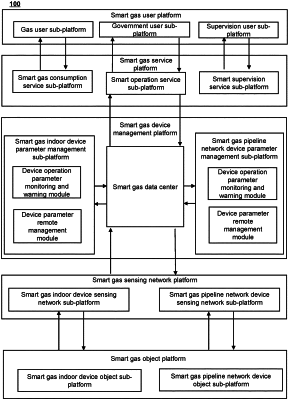| CPC G01D 18/00 (2013.01) [G16Y 10/35 (2020.01); G16Y 40/10 (2020.01); G16Y 40/20 (2020.01)] | 4 Claims |

|
1. A method for diagnosing accuracy of a smart gas ultrasonic meter, wherein the method is implemented by a smart gas device management platform of an Internet of Things (IoT) system for diagnosing accuracy of the smart gas ultrasonic meter, and the method comprises:
acquiring gas attribute data of gas passing through a metering device based on a distributed sensor deployed in a gas pipeline network, wherein the gas attribute data includes gas density, composition and mass, fluid pulsation, and flow rate profile;
determining a first accuracy risk of the metering device through performing pre-diagnosis on the metering device based on the gas attribute data and metering device information, wherein the metering device information includes a type, a service life, and a location, and the first accuracy risk refers to a pre-diagnosed possible abnormal metering device and an abnormal possibility thereof, wherein
the determining a first accuracy risk of the metering device through performing pre-diagnosis on the metering device based on the gas attribute data and metering device information includes:
predicting a predicted gas flow of at least one point in a gas pipeline in a future period based on historical gas monitoring data;
determining a suspect metering device based on the predicted gas flow and gas monitoring data of the metering device; and
evaluating the first accuracy risk of the suspect metering device based on the gas attribute data and the metering device information:
determining a second accuracy risk of the metering device through performing precision diagnosis on the metering device based on a pre-diagnosis result, wherein the second accuracy risk refers to a possibility of accuracy abnormality of the possible abnormal metering device, wherein
the determining a second accuracy risk of the metering device through performing precision diagnosis on the metering device based on a ore-diagnosis result includes:
in response to the first accuracy risk of at least one metering device satisfying a preset risk condition, evaluating the second accuracy risk of the at least one metering device in a gas area based on the first accuracy risk and the gas monitoring data, wherein the preset risk condition refers to a count of metering devices with the first accuracy risk exceeding a first risk threshold reaching a quantity alert value, and the first risk threshold is related to a data monitoring frequency of the metering device, wherein
the in response to the first accuracy risk of at least one metering device satisfying a preset risk condition, evaluating the second accuracy risk of the at least one metering device in a gas area based on the first accuracy risk and the gas monitoring data includes:
constructing an accuracy diagnosis map based on the metering device in the gas area, wherein nodes of the accuracy diagnosis map include the metering device, edges of the accuracy diagnosis map include gas pipelines between the nodes, attributes of the nodes include types of the metering devices, locations of the nodes in the gas pipeline network, the gas monitoring data, gas theoretical data, the first accuracy risk, flow rate monitoring data, pressure monitoring data, and historical calibration records corresponding to the metering devices; and
determining, based on the accuracy diagnosis map, the second accuracy risk of the at least one metering device in the gas area through a pipeline network diagnosis model, the pipeline network diagnosis model being a machine learning model; and
displaying detection indication information to the smart gas device management platform based on a precision diagnosis result.
|